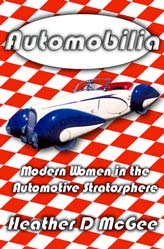|

|
||||||||||||||||
|
Automobilia: Modern Women in the Automotive Stratosphere Heather D. McGee
Have you ever met a female gold-miner who builds racecars? How about a female Harley rider who owns 21 cars? A female hacker who built her own electric car? A female automotive historian with a classic Mercedes fetish? A 16-year-old Australian girl who's been racing half her life? Me neither, until I started writing my new book. Automobilia: Modern Women in the Automotive Stratosphere, to be published in Spring 2000 by Eve's Eye Press, is for and about free-thinking women
This book focuses on the celebration of cars in women's lives -- the serious owners, racers, mechanics, pit crew members, shop teachers -- women who'd rather drive than eat, women who'd rather fix it themselves so they know it's done right, women who live for and find liberation in speed. Further, the focus is on vintage, classic, milestone, antique, historical, and race cars in women's lives -- the importance of the gearhead mindset, the cultural implications and advantages of automotive knowledge, the strength and freedom cars can bring to women's lives, the acquisition of the right car, the enjoyment of automobiles for their own sake, the threat to auto-tradition, and the physics behind it all.
And in my own humble way, I've also tried to make this book as smart, entertaining, and inspiring as the women who contributed and are featured. There's a bit of women's history, feminist philosophy, and lots of funny reading thrown in for good measure. Familiar to fans of Distant Thunder and the Thunder Valley racers are Ruth Wolf, who wrote a piece entitled "Everybody's Looking for Something: Life in a Specialty Auto Shop" and Lisa Devlin, who wrote a short race diary entitled "Into the Ditch: A Racer's Diary with a Happy Ending." Also included are:
As Teri Olcott states in her contribution to the book:
All that has changed, radically. Even in the 1800s, some women were not satisfied being excluded from the automotive world due to the restrictions of social propriety. These women, including suffragists, set out on cross-country trips, modified their clothing according to function rather than fashion, and opened up their worlds via their -- or their male relatives' -- automobiles. There have been and always will be women who drive cars for the rumble of the motor, the pleasure of motion, the attraction to freedom, the danger of speed, and the smell of petroleum products (and did I mention the danger of speed?).
Women who -- surprise! -- lift hoods, adjust timing, perform tuneups, change oil, drain radiators, bleed brakes. Women who blueprint and rebuild performance motors, delicately tune carburetors, convert drum brakes to disc, isolate elusive electrical problems. Women who race top-fuel dragsters and become four-time world champions -- yes of the whole world, not the women's division of the whole world. I was shocked by how reluctant some people have been to believe that there are women out there who love cars and racing, that there is possibly an audience for a book such as this. Incredible books like Taking the Wheel by Virginia Scharff, Women at the Wheel by Marilyn Root, and Ladies, Start Your Engines by Elinor Nauen have paved the way. Conversely, I have been constantly amazed by the high-caliber intelligence, energy, and generosity of the automotive women I've met -- some of whom have become friends.
Heather D. McGee
|
||||||||||||||||
